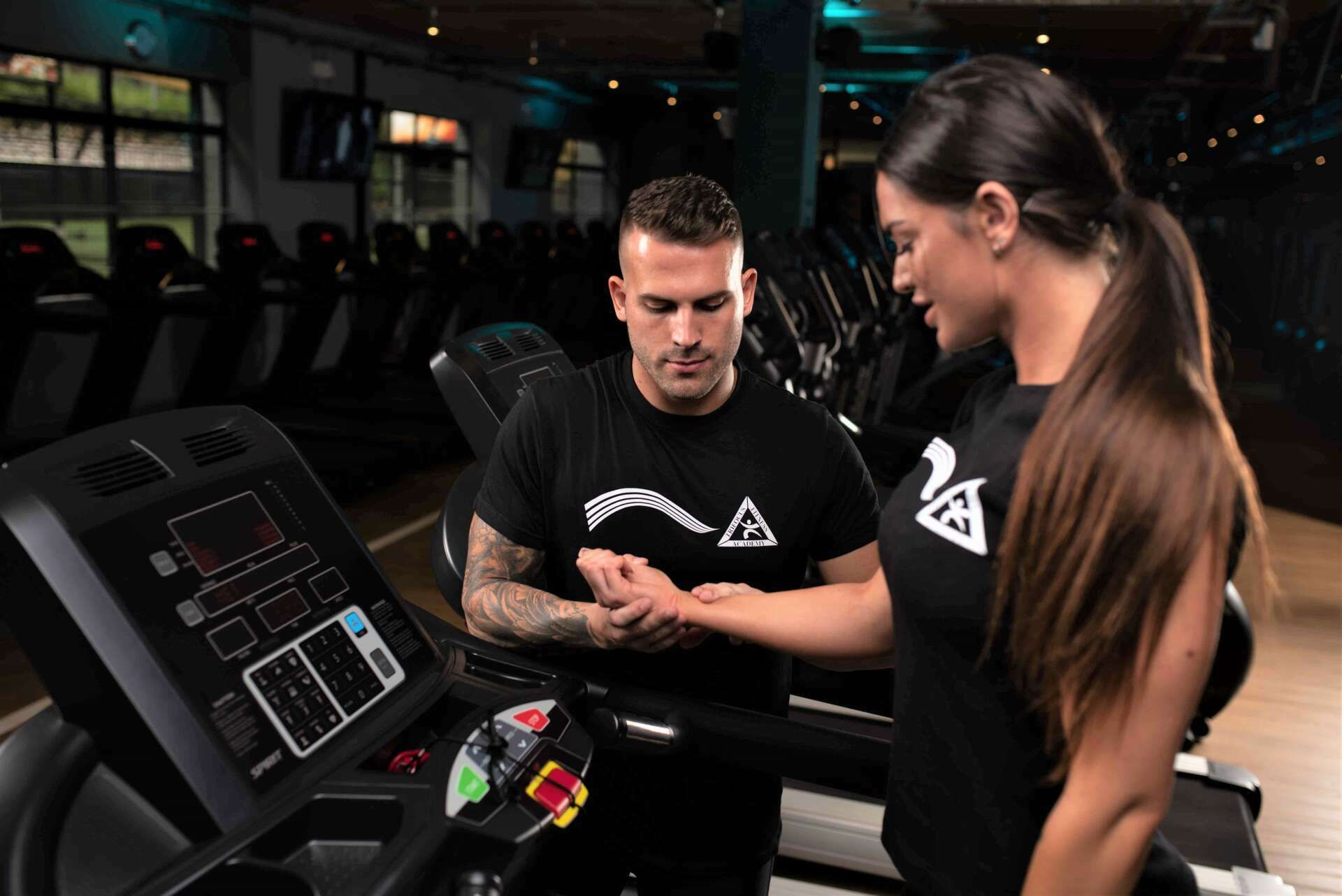

Featured
How To Exercise Your Heart
Published: September 29, 2023
Learn how to exercise your heart with our featured fitness tips and workouts. Improve your cardiovascular health and live a healthier lifestyle today.
Introduction
Keeping your heart healthy is crucial for overall well-being and longevity. One of the best ways to achieve this is through regular exercise. Exercise not only helps to strengthen the heart muscle but also improves blood circulation, reduces the risk of heart disease, and enhances your overall fitness level.
Engaging in heart-healthy exercise not only benefits your cardiovascular system but also boosts your mood, improves sleep, and increases energy levels. Whether you are a fitness enthusiast or a beginner, incorporating exercises specifically targeting the heart can significantly improve your overall health and quality of life.
However, with the vast array of exercise options and conflicting information available, it can be overwhelming to determine the best approach to effectively exercise your heart. That’s why this article is here to guide you through the process, providing you with valuable tips and insights on the most effective ways to exercise your heart.
From cardio exercises that get your heart pumping to strength training routines that improve heart muscle function, we will explore the various strategies and precautions to help you ensure a heart-healthy workout. Before delving into the specifics, let’s first understand why exercising your heart is so important.
Importance of Exercising the Heart
Regular physical activity is essential for maintaining a healthy heart. Exercising the heart provides numerous benefits, both in the short term and in the long run. Here’s why exercising your heart is so important:
- Strengthens the heart muscle: Just like any other muscle in the body, the heart needs exercise to stay strong and function optimally. When you engage in cardiovascular exercises, such as running, swimming, or cycling, your heart works harder, pumping blood more efficiently and becoming stronger over time.
- Improves blood circulation: Regular exercise helps improve blood flow throughout the body, including to the heart. This increased blood circulation delivers oxygen and nutrients to the muscles and organs, while also removing waste products. By enhancing blood circulation, you reduce the risk of developing cardiovascular diseases, such as heart attacks and strokes.
- Reduces the risk of heart disease: Physical inactivity is a significant risk factor for heart disease. By incorporating regular exercise into your routine, you can lower your blood pressure, maintain healthy cholesterol levels, and prevent the buildup of plaque in the arteries. These factors significantly reduce the risk of developing heart disease.
- Controls weight: Regular exercise helps to maintain a healthy weight or contributes to weight loss. Excess weight, especially around the waist, increases the strain on the heart and raises the risk of heart disease. By engaging in physical activity, you can shed excess pounds and maintain a healthy body weight, relieving stress on the heart.
- Boosts overall fitness and endurance: Exercise not only benefits the heart but also improves overall fitness levels. Regular physical activity increases stamina and endurance, allowing you to engage in daily activities with ease and energy. This translates into a better quality of life and greater longevity.
By incorporating regular exercise that targets the heart into your routine, you can enjoy these numerous benefits. It’s important to note that the right type, intensity, and duration of exercise will vary depending on your fitness level and any underlying health conditions. Consult with a healthcare professional before starting any exercise program to ensure it is safe and appropriate for you.
Guidelines for Exercising
Before you dive into a heart-healthy workout routine, it is important to understand and follow some key guidelines. These guidelines will help you exercise safely and effectively, maximizing the benefits for your heart and overall health. Here are some essential guidelines to consider:
- Start with a warm-up: Prior to every workout session, it is crucial to warm up your body. This helps increase blood flow, loosens up joints, and prepares your muscles for the upcoming exercise. Spend at least 5-10 minutes engaging in light cardio activities such as brisk walking or jogging, and perform dynamic stretches to warm up major muscle groups.
- Choose activities you enjoy: The key to sticking with an exercise routine is finding activities that you enjoy. Whether it’s dancing, swimming, cycling, or playing a sport, choose exercises that you genuinely look forward to. This will make your workouts more pleasurable and increase your chances of staying consistent.
- Gradually increase intensity: If you’re new to exercise or returning after a long break, it’s important to gradually increase the intensity of your workouts. Begin at a comfortable level and slowly increase the duration and intensity over time. This gradual progression allows your body to adapt to the increased demands and reduces the risk of injury.
- Listen to your body: Pay attention to how your body feels during exercise. It’s normal to feel exertion and fatigue, but if you experience any sharp pain or unusual discomfort, it’s important to stop and seek medical advice. Push yourself, but also know your limits and respect your body’s signals.
- Stay hydrated: Hydration is important during exercise to maintain the optimal functioning of your body. Drink water before, during, and after your workouts to stay adequately hydrated. The exact amount of water you need may vary depending on factors such as climate, intensity of exercise, and individual needs.
- Incorporate rest days: Allow your body to recover and rebuild by incorporating regular rest days into your exercise routine. Rest days are just as important as active workout days, as they help prevent overuse injuries and allow your muscles to repair and strengthen. Listen to your body and take rest days when needed.
- Track your progress: Keep a record of your workouts, noting the duration, intensity, and type of exercise you perform. Tracking your progress can help you stay motivated, monitor improvements in your fitness level, and identify any necessary adjustments to your routine.
By following these guidelines, you can ensure a safe and effective workout routine that promotes heart health and overall well-being. Remember, consistency is key. Aim to exercise for at least 150 minutes of moderate-intensity aerobic activity or 75 minutes of vigorous-intensity aerobic activity each week. Be patient, stay committed, and enjoy the journey towards a healthier heart.
Cardiovascular Exercises
Cardiovascular exercises, also known as aerobic exercises, are an essential component of any heart-healthy workout routine. These exercises elevate your heart rate, working your cardiovascular system and improving its efficiency. Here are some effective cardiovascular exercises to incorporate into your workout regimen:
- Brisk walking: Walking is a low-impact exercise that can be easily incorporated into your daily routine. Start with a leisurely stroll and gradually increase your pace to brisk walking. Aim for at least 30 minutes of brisk walking most days of the week.
- Running or jogging: Running or jogging is an excellent way to elevate your heart rate and burn calories. It can be done outdoors or on a treadmill. Start with shorter distances or intervals and gradually increase your endurance and speed over time.
- Cycling: Whether you prefer outdoor cycling or using a stationary bike, cycling is a great cardiovascular exercise. It not only improves heart health but also strengthens the lower body muscles. Aim for at least 30 minutes of moderate to vigorous cycling several times a week.
- Swimming: Swimming is a low-impact, full-body workout that is gentle on the joints. It provides a great cardiovascular workout while also toning the muscles. If swimming is accessible to you, aim for 30 minutes of continuous swimming a few times a week.
- Aerobic dance or Zumba: These types of dance-based workouts combine cardio exercises with fun movements and rhythms. They are a great way to get your heart rate up while enjoying yourself. Join a class or follow online tutorials to groove your heart out.
- Jumping rope: Jumping rope is a simple yet effective cardiovascular exercise that can be done anywhere. It not only elevates your heart rate but also improves coordination and agility. Start with short intervals and gradually increase the duration as you build endurance.
- HIIT workouts: High-Intensity Interval Training (HIIT) involves short bursts of intense exercise followed by periods of active rest. This type of training challenges and strengthens the heart while burning calories. Incorporate HIIT exercises such as burpees, high knees, or mountain climbers into your routine.
Remember to choose cardiovascular exercises that you enjoy and that suit your fitness level. Aim for at least 150 minutes of moderate-intensity aerobic activity or 75 minutes of vigorous-intensity aerobic activity each week to reap the maximum benefits for your heart.
Strength Training for the Heart
While cardiovascular exercises are essential for heart health, incorporating strength training into your workout routine can provide additional benefits. Strength training helps to improve heart muscle function, increase endurance, and enhance overall fitness. Here’s how you can incorporate strength training exercises to strengthen your heart:
- Weightlifting: Resistance training using free weights, weight machines, or even your body weight can help build muscle strength and endurance. Start with lighter weights and gradually increase the resistance as you become stronger. Focus on exercises that target major muscle groups, such as squats, lunges, chest presses, and rows.
- Bodyweight exercises: You don’t need fancy equipment to engage in strength training. Exercises like push-ups, planks, squats, lunges, and burpees use your own body weight to provide resistance and build strength. Incorporate a combination of bodyweight exercises into your routine to challenge your muscles and elevate your heart rate.
- Circuit training: Circuit training involves performing a series of exercises with minimal rest in between. This type of training combines strength exercises with cardiovascular exercises, creating a heart-pumping workout. Design a circuit that includes a mix of strength exercises and cardio intervals, such as jumping jacks or mountain climbers.
- Pilates and yoga: Pilates and yoga are excellent forms of strength training that focus on core stability, balance, and flexibility. These exercises improve overall body strength and posture, contributing to better heart health. Look for classes or online tutorials that incorporate dynamic movements and poses to challenge your muscles.
- Resistance band exercises: Resistance bands are versatile and portable tools that can be used for strength training. They provide resistance throughout the range of motion, helping to strengthen muscles without putting excessive strain on the joints. Incorporate exercises like bicep curls, tricep extensions, and lateral band walks into your routine.
When incorporating strength training into your routine, aim for at least two sessions per week, targeting all major muscle groups. Start with lighter weights and gradually increase the resistance as you progress. Allow for proper rest and recovery between sessions to allow your muscles to repair and grow stronger.
Remember, strength training complements cardiovascular exercises and contributes to overall heart health. It not only improves heart muscle function but also helps to increase metabolism, maintain a healthy body weight, and enhance bone density.
Tips for a Heart-Healthy Workout
To make the most out of your heart-healthy workout routine, it’s important to incorporate some key tips and strategies. These tips will not only enhance the effectiveness of your workout but also ensure the safety and well-being of your heart. Here are some essential tips to keep in mind:
- Consult with a healthcare professional: Before starting any exercise program, especially if you have any pre-existing medical conditions or are new to exercise, it’s important to consult with a healthcare professional. They can provide guidance on appropriate exercises and any precautions you should take.
- Warm up and cool down: Begin each workout session with a proper warm-up to prepare your body for exercise and gradually increase your heart rate. And don’t forget to cool down after your workout, engaging in light stretching and gradually reducing your heart rate. This helps prevent muscle soreness and promotes recovery.
- Monitor your heart rate: Keeping an eye on your heart rate during exercise can help ensure that you’re working out at a safe and effective intensity. You can use a heart rate monitor or simply check your pulse manually. Aim for a target heart rate that corresponds to your age and fitness level.
- Stay hydrated: Drink plenty of water before, during, and after your workout to stay properly hydrated. Dehydration can put stress on your heart and reduce exercise performance. Sip water throughout your workout to replenish lost fluids and electrolytes.
- Breathe properly: During exercise, focus on deep and controlled breathing. Inhale deeply through your nose and exhale fully through your mouth. Proper breathing techniques help deliver oxygen to your muscles and enhance endurance.
- Listen to your body: Pay attention to how your body feels during and after exercise. If you feel any pain, dizziness, or unusual discomfort, stop exercising and seek medical advice. Push yourself, but also know your limits and respect your body’s limits.
- Mix up your routine: Variety is key to keep your workouts interesting and prevent plateaus. Try different exercises, change the duration or intensity of your workouts, and incorporate new activities to challenge your body and keep your heart guessing.
- Get enough rest and recovery: Allow your body time to rest and recover between workouts. This helps prevent overuse injuries and gives your muscles time to repair and grow stronger. Aim for at least one or two rest days each week.
- Stay consistent: Consistency is key when it comes to reaping the benefits of exercise. Aim to make physical activity a regular part of your daily routine. Even if you can’t dedicate a lot of time, short bursts of exercise throughout the day can still make a difference.
By following these tips, you can create a heart-healthy workout routine that is safe, effective, and enjoyable. Remember, the key is to find activities that you enjoy and that suit your fitness level. Make exercise a priority and make it a lifelong habit for a healthy heart and a vibrant life.
Precautions and Safety Measures
While exercise is generally safe and beneficial for the heart, it’s important to take certain precautions and follow safety measures to ensure a safe and enjoyable workout experience. Here are some precautions and safety measures to keep in mind:
- Consult with a healthcare professional: If you have any underlying medical conditions or are new to exercise, it’s important to consult with a healthcare professional before starting an exercise program. They can help assess any potential risks and provide personalized recommendations.
- Start gradually: If you’re new to exercise or returning after a long break, it’s crucial to start slowly and gradually increase the intensity and duration of your workouts. This allows your body to adjust and prevents overexertion or injury.
- Use proper form and technique: Performing exercises with proper form and technique is essential to prevent injuries. If you’re unsure about how to perform a certain exercise, seek guidance from a qualified fitness professional or watch instructional videos online.
- Listen to your body: Pay attention to any signs of pain, dizziness, or excessive fatigue during your workouts. If something doesn’t feel right, stop exercising and seek medical advice if necessary. Push yourself, but also know when to rest and recover.
- Avoid overexertion: While it’s important to challenge yourself, avoid overexertion or pushing yourself to the point of exhaustion. This can put unnecessary strain on your heart and increase the risk of injury. Listen to your body and give yourself time to recover between workouts.
- Stay hydrated: Proper hydration is crucial for maintaining the optimal functioning of your body during exercise. Drink water before, during, and after your workouts to stay adequately hydrated. Avoid excessive caffeine or sugary drinks, as they can dehydrate you.
- Wear appropriate workout attire: Make sure to wear comfortable, breathable clothing and supportive footwear during your workouts. This will help prevent discomfort and reduce the risk of injuries, such as blisters or sprains.
- Use safety equipment: Depending on the type of exercise you’re engaging in, use appropriate safety equipment. For activities such as cycling or rollerblading, wear a helmet. If lifting weights, use collars on barbells and use a spotter if necessary.
- Don’t ignore pain: If you experience any persistent or sharp pain during or after exercise, it’s important not to ignore it. Pain is your body’s way of signaling that something is wrong. Stop exercising and seek medical advice if the pain persists.
By taking these precautions and following safety measures, you can minimize the risk of injuries and ensure a safe and effective workout routine. Always prioritize your health and well-being when engaging in physical activity, and remember that it’s better to be cautious than to risk unnecessary harm.
Conclusion
Incorporating heart-healthy exercises into your routine is essential for maintaining a strong and healthy cardiovascular system. Regular exercise not only strengthens your heart muscle but also improves blood circulation, reduces the risk of heart disease, and boosts overall fitness and well-being.
By following the guidelines for exercising, including warming up, choosing activities you enjoy, and gradually increasing intensity, you can ensure a safe and effective workout routine. Cardiovascular exercises like brisk walking, running, cycling, and swimming elevate your heart rate and improve heart health. Incorporating strength training exercises, such as weightlifting, bodyweight exercises, and resistance band workouts, further strengthens the heart muscle and improves overall fitness.
To make the most out of your heart-healthy workouts, we discussed several tips, including proper warm-up and cool-down, monitoring your heart rate, staying hydrated, and listening to your body. Additionally, we emphasized the importance of consulting with a healthcare professional, using proper form and technique, and taking necessary precautions to ensure safety.
Remember, consistency and enjoyment are key to long-term success. Find activities you enjoy and make exercise a regular part of your routine. Even small amounts of activity can make a significant difference in your heart health. Stay committed, be patient with yourself, and celebrate your progress along the way.
So, lace up your sneakers, grab your water bottle, and embrace the journey towards a healthier heart. With the right exercises, precautions, and dedication, you can achieve optimal heart health, enhance your overall well-being, and enjoy a more vibrant and fulfilling life.








